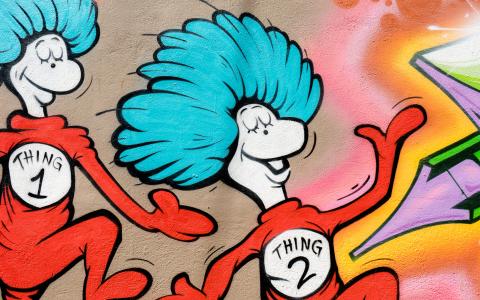
The overdue decision to stop publishing certain Dr. Seuss books because they contain racist imagery has caused quite a hullabaloo — a Seussian word, if there ever was one.
But amid all the ruckus about “cancel culture” — that’s not what this is, by the way — it was surprising to discover how profitable the Dr. Seuss universe continues to be. Eight decades after the publication of his first children’s book — “And to Think That I Saw It on Mulberry Street,” which is among the works being discontinued — the author’s oeuvre still makes a whole heaping lot of money.
In fact, according to Forbes.com’s annual inventory of the highest-paid dead celebrities, the guy who grew up Theodor Geisel in Springfield ranks No. 2 — behind only Michael Jackson — with earnings last year of $33 million. In other words, the Vipper of Vipp, Flummox, and Fox in Sox generated more dough in 2020 than the songs of Elvis Presley or Prince, or the panels of “Peanuts” creator Charles Schulz.
And Dr. Seuss stands to make even more money now. That’s because the announcement that six of his 60 or so books will no longer be published has sent people scurrying to buy his back catalog. On Thursday, nine of the top 10 spots on Amazon’s best-sellers list were occupied by Dr. Seuss, including classics “The Cat in the Hat,” “One Fish, Two Fish, Red Fish, Blue Fish” and “Oh, the Places You’ll Go!”
A fortune’s a fortune, no matter how small, but $33 million is a mountain that’s tall. So how does Dr. Seuss continue to accumulate such wealth? It turns out Geisel, who died in 1991 at the age of 87, doesn’t deserve the credit. His wife does. Two years after the author died, Seuss’s spouse, Audrey Geisel, founded Dr. Seuss Enterprises to handle licensing and film deals for her husband’s work.
Audrey died in 2018, but Dr. Seuss Enterprises lives on, and it’s shrewdly built the Seuss brand with products — plush toys, cards, bath towels, and sun hats, to name just a few — and a variety of TV and film projects, notably the animated “Green Eggs and Ham” series, which debuted on Netflix in 2019, starring Michael Douglas, Keegan-Michael Key, Diane Keaton, and other famous voices.
That’s not all: Pre-pandemic, there was “Seuss at Sea,” a popular — and lucrative — partnership with Carnival Cruises that, naturally, featured a green-eggs-and-ham breakfast buffet for kids. And there are three major movies in the works, including an animated adaptation of “Oh, the Places You’ll Go!” — produced by J.J. Abrams, no less — another version of “The Cat in the Hat” and “Thing One and Thing Two.”
Past Seuss projects include Jim Carrey’s “The Grinch” in 2000; Mike Myers’s mediocre “The Cat in the Hat” in 2003, “Horton Hears a Who!” in 2008; and the 2001 Broadway bomb “Seussical.”
Deborah Wagnon, a longtime entertainment attorney who teaches at Middle Tennessee State University, says most best-selling authors or songwriters don’t thrive after death the way Seuss has. Usually, she says, that’s because the artist didn’t own the copyright to their work, or there’s acrimony among the artist’s heirs that leaves everything in limbo.
As an example, Wagnon cites author John Steinbeck, whose relatives have spent years litigating control of the Nobel Prize-winning author’s works. As a result, potential money-making movie deals — including a long-gestating Steven Spielberg adaptation of “The Grapes of Wrath” and a remake of “East of Eden” starring Jennifer Lawrence — have been blocked. (The Geisels didn’t have children — “you make ‘em, I amuse ‘em,” Seuss once said — so there’s no nasty infighting among heirs to thwart potential deals.)
The flipside, Wagnon says, is Frank Sinatra, whose estate has done a masterful job of controlling and perpetuating the singer’s music and likeness. It continues to negotiate fees for licensing the Sinatra brand — a slot machine in Las Vegas with his signature fedora and a snippet of a song by “Ol’ Blue Eyes,” for example — and each of these agreements can yield a significant royalty stream.
“You have to be focused. This is a job,” Wagnon says. “It’s not just about money. It’s about keeping the work alive.”
Whether or not she would ever buy a pair of Billabong’s “One Fish, Two Fish” boardshorts, Wagnon says it’s gratifying see the Dr. Seuss estate prosper.
“It’s a beautiful thing,” she says. “Mostly for the work. Dr. Seuss created something entertaining and informative for children, and the point is to see and know the work for as long as possible.”
It’s no coincidence, of course, that the entity in charge of building the Seuss brand also made the decision to stop publishing the half-dozen Dr. Seuss titles with offensive imagery. Explaining the move, Dr. Seuss Enterprises said what they meant and they meant what they said: “These books portray people in ways that are hurtful and wrong.”
Meanwhile, the news hasn’t affected attendance at the Amazing World of Dr. Seuss Museum in Springfield, where parents and kids are still going, despite the pandemic, to get a gander at some of Geisel’s fanciful creations.
If you’ve never visited, you should sometime. These things are fun and fun is good.
This article originally appeared on the Boston Globe.



